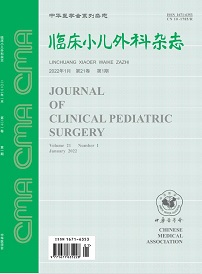Ding Ning,Cheng Ziqin,Liu Zhiwen.Clinical application of continuous rectal tube drainage in the treatment of Hirschsprung disease[J].Journal of Clinical Pediatric Surgery,,23():1049-1053.[doi:10.3760/cma.j.cn101785-202307061-009]
Clinical application of continuous rectal tube drainage in the treatment of Hirschsprung disease
- Keywords:
- Hirschsprung Disease; Surgical Procedures; Operative; Child
- Abstract:
- Objective To explore the application value of continuous defecation through indwelling anal canal in the conservative treatment period prior to surgery for Hirschsprung disease in infants. Methods This retrospective study included 80 infants with Hirschsprung disease treated at the Department of Neonatal Surgery,Jiangxi Children’s Hospital,from January 2019 to January 2023.Based on different methods of auxiliary defecation during the conservative treatment period,the infants were divided into a study group with long-term anal canal retention and a control group receiving enema and anal dilation.The study group was further divided into common type (Group A,n=21) and long segment type (Group C,n=11),while the control group was divided into common type (Group B,n=33) and long segment type (Group D,n=15).Compliance with tube placement was statistically analyzed.The four subgroups were paired for comparison (A&B/C&D) regarding gender,birth weight,age at first visit,age at definitive surgery,surgical method,incidence of small intestine-colonitis related to Hirschsprung disease,rate of colostomy,weight at definitive surgery,duration of surgery,length of resected bowel,maximum diameter of dilated segments in postoperative specimens,histological inflammation of bowel walls,postoperative complications,length of hospital stay,and hospitalization costs. Results There were no statistically significant differences among groups in age at first visit,birth weight,age at definitive surgery,gender,or surgical method (P>0.05).There were also no statistically significant differences in colostomy rates,weight at definitive surgery,duration of surgery,length of resected bowel,histological inflammation of bowel walls,postoperative complications,days in hospital,or hospitalization costs between Groups A and B (P>0.05).For Groups C and D,there were no statistically significant differences in weight at definitive surgery,duration of surgery,or length of resected bowel (P>0.05).In Group A,3 cases of small intestine-colonitis related to Hirschsprung disease occurred,compared to 14 in Group B; the average maximum diameter of dilated segments in Group A was (3.00±0.59) cm,and (3.77±0.64) cm in Group B.In Group C,2 cases of small intestine-colonitis occurred,while Group D had 9 cases; no colostomy cases occurred in Group C,compared to 6 in Group D; the maximum diameter in Group C was (3.09±0.49) cm,and (3.9±0.55) cm in Group D; Group C had 1 case of histological inflammation,while Group D had 8 cases; Group C experienced 2 postoperative complications,while Group D had 10; Group C had an average hospital stay of (32.73±6.37) days,while Group D had (53.60±15.78) days; the average hospitalization costs for Group C was (53 891.29±10 317.25) yuan,and (81 400.33±27 393.87) yuan for Group D; all differences were statistically significant (P<0.05). Conclusions Long-term placement of a rectal tube before definitive surgery can reudrce the incidence of small intestine-colonitis related to Hirschsprung disease in newborns and infants,prevent proximal bowel dilation and hypertrophy.In long segment types,it can significantly reduce the incidence of postoperative complications,decrease the rate of colostomy,alleviate suffering,promote surgical recovery,shorten hospital time,and reduce hospitalization costs.
References:
[1] Pini Prato A,Rossi V,Avanzini S,et al.Hirschsprung’s disease:what about mortality?[J].Pediatr Surg Int,2011,27(5):473-478.DOI:10.1007/s00383-010-2848-2.
[2] Gosain A,Frykman PK,Cowles RA,et al.Guidelines for the diagnosis and management of Hirschsprung-associated enterocolitis[J].Pediatr Surg Int,2017,33(5):517-521.DOI:10.1007/s00383-017-4065-8.
[3] Elhalaby EA,Teitelbaum DH,Coran AG,et al.Enterocolitis associated with Hirschsprung’s disease:a clinical histopathological correlative study[J].J Pediatr Surg,1995,30(7):1023-1027.DOI:10.1016/0022-3468(95)90334-8.
[4] Kastenberg ZJ,Taylor MA,Durham MM,et al.Perioperative and long-term functional outcomes of neonatal versus delayed primary endorectal pull-through for children with Hirschsprung disease:a pediatric colorectal and pelvic learning consortium study[J].J Pediatr Surg,2021,56(8):1465-1469.DOI:10.1016/j.jpedsurg.2021.04.024.
[5] Westfal ML,Okiemy O,Chung PHY,et al.Optimal timing for Soave primary pull-through in short-segment Hirschsprung disease:a meta-analysis[J].J Pediatr Surg,2022,57(4):719-725.DOI:10.1016/j.jpedsurg.2021.07.007.
[6] 王吉,李智.先天性巨结肠非手术治疗研究进展[J].临床小儿外科杂志,2022,21(2):186-190.DOI:10.3760/cma.j.cn101785-202104064-016. Wang J,Li Z.Recent advances of non-surgical treatment of Hirschsprung’s disease[J].DOI:10.3760/cma.j.cn101785-202104064-016.
[7] Mochizuki K,Shinkai M,Kitagawa N,et al.Continuous transanal decompression for infants with long-and total-type Hirschsprung’s diseases as a bridge to curative surgery:a single-center experience[J].Surg Case Rep,2017,3(1):42.DOI:10.1186/s40792-017-0318-y.
[8] 李萍,汪健,黄顺根,等.经肛门导管持续引流和间隙灌洗用于新生儿长段型巨结肠的治疗和术前准备[J].中国血液流变学杂志,2010,20(2):282-283,304.DOI:10.3969/j.issn.1009-881X.2010.02.041. Li P,Wang J,Huang SG,et al.Transanal catheter fixation and simple frequent tube washouts in long segment-type Hirschsprung’s disease[J].Chin J Hemorheol,2010,20(2):282-283,304.DOI:10.3969/j.issn.1009-881X.2010.02.041.
[9] 李颀,孔赤寰,张震,等.经肠镜放置减压管后腹腔镜一期根治术治疗长段型先天性巨结肠[J].中华小儿外科杂志,2018,39(12):889-894.DOI:10.3760/cma.j.issn.0253-3006.2018.12.003. Li Q,Kong CH,Zhang Z,et al.Endoscopic placement of decompression tube for long-segment Hirschsprung’s disease[J].Chin J Pediatr Surg,2018,39(12):889-894.DOI:10.3760/cma.j.issn.0253-3006.2018.12.003.
Memo
收稿日期:2023-7-31。
基金项目:江西省卫生健康委科技计划项目(202310997)
通讯作者:刘智文,Email:tinkerlzw@126.com
